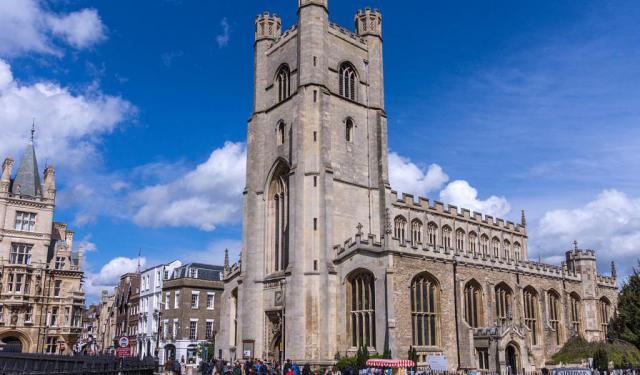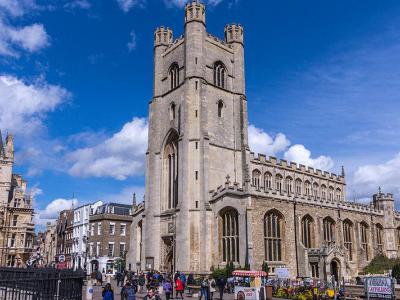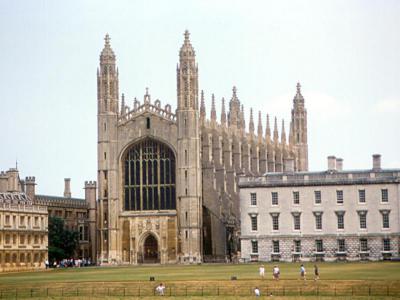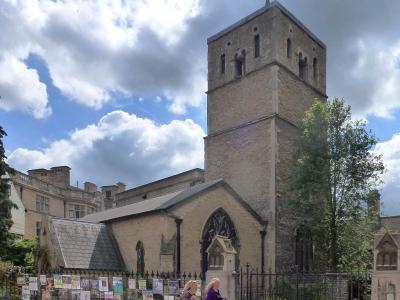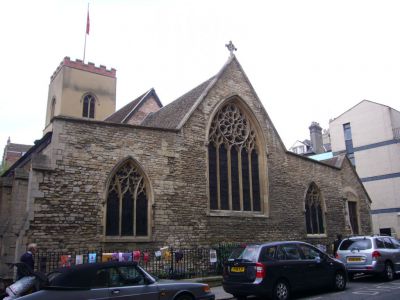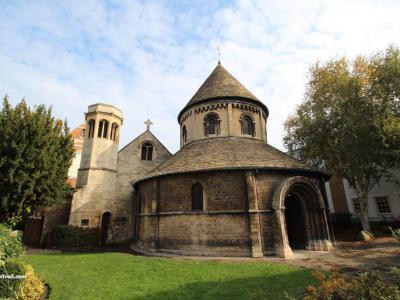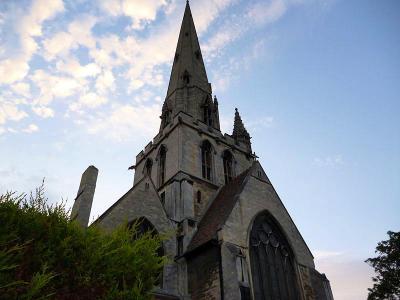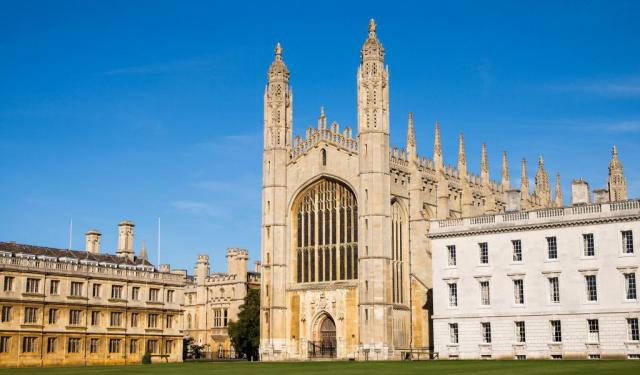Historical Religious Buildings (Self Guided), Cambridge
Renowned for its academic excellence, Cambridge is also steeped in religious history. It has quite a few churches dating back hundreds of years, some even predating the Anglican Church itself. These historical sanctuaries have stood the test of time and today offer a glimpse into the city's religious and architectural heritage.
Great Saint Mary's Church, a stunning example of English Gothic architecture, has occupied the site at the heart of Cambridge, in one form or another, since the early 13th century. Its distinctive tower, a bit younger, offers breathtaking panoramic views of the city.
King's College Chapel is an iconic masterpiece, nestled within the prestigious King's College. Built in the 15th century, its magnificent fan-vaulted ceiling and intricate stained glass windows are a testament to the city's religious devotion and architectural prowess.
Saint Bene't's Church holds the distinction of being Cambridge's oldest standing building, with parts of it dating back to the Anglo-Saxon era. Its simple yet charming design reflects the city's early Christian history.
Saint Edward King and Martyr, a modest church, is notable for its peaceful atmosphere and historical significance. It commemorates the memory of Saint Edward, the martyred King of England.
Holy Trinity Church, situated further ahead, is an elegant Georgian-era temple known for its graceful architecture and serene ambiance. It has played an essential role in the spiritual life of Cambridge for centuries.
The Church of the Holy Sepulchre is an intriguing round church, one of only four in England. It's modeled after the Church of the Holy Sepulchre in Jerusalem and is an architectural gem.
All Saints' Church, with its distinctive spire, adds a touch of grandeur to the cityscape. This 19th-century church is a replacement for a medieval predecessor that had stood there for 600 years and is known for its impressive wall paintings.
The historical churches in Cambridge offer not only a glimpse into the city's past but also an opportunity for quiet reflection and spiritual connection. If you are keen on the history of Christianity, follow this self-guided walk along the streets of Cambridge and discover some of its most famous places of worship that have shaped the city's cultural identity for centuries!
Great Saint Mary's Church, a stunning example of English Gothic architecture, has occupied the site at the heart of Cambridge, in one form or another, since the early 13th century. Its distinctive tower, a bit younger, offers breathtaking panoramic views of the city.
King's College Chapel is an iconic masterpiece, nestled within the prestigious King's College. Built in the 15th century, its magnificent fan-vaulted ceiling and intricate stained glass windows are a testament to the city's religious devotion and architectural prowess.
Saint Bene't's Church holds the distinction of being Cambridge's oldest standing building, with parts of it dating back to the Anglo-Saxon era. Its simple yet charming design reflects the city's early Christian history.
Saint Edward King and Martyr, a modest church, is notable for its peaceful atmosphere and historical significance. It commemorates the memory of Saint Edward, the martyred King of England.
Holy Trinity Church, situated further ahead, is an elegant Georgian-era temple known for its graceful architecture and serene ambiance. It has played an essential role in the spiritual life of Cambridge for centuries.
The Church of the Holy Sepulchre is an intriguing round church, one of only four in England. It's modeled after the Church of the Holy Sepulchre in Jerusalem and is an architectural gem.
All Saints' Church, with its distinctive spire, adds a touch of grandeur to the cityscape. This 19th-century church is a replacement for a medieval predecessor that had stood there for 600 years and is known for its impressive wall paintings.
The historical churches in Cambridge offer not only a glimpse into the city's past but also an opportunity for quiet reflection and spiritual connection. If you are keen on the history of Christianity, follow this self-guided walk along the streets of Cambridge and discover some of its most famous places of worship that have shaped the city's cultural identity for centuries!
How it works: Download the app "GPSmyCity: Walks in 1K+ Cities" from Apple App Store or Google Play Store to your mobile phone or tablet. The app turns your mobile device into a personal tour guide and its built-in GPS navigation functions guide you from one tour stop to next. The app works offline, so no data plan is needed when traveling abroad.
Historical Religious Buildings Map
Guide Name: Historical Religious Buildings
Guide Location: England » Cambridge (See other walking tours in Cambridge)
Guide Type: Self-guided Walking Tour (Sightseeing)
# of Attractions: 7
Tour Duration: 1 Hour(s)
Travel Distance: 1.3 Km or 0.8 Miles
Author: sylvia
Sight(s) Featured in This Guide:
Guide Location: England » Cambridge (See other walking tours in Cambridge)
Guide Type: Self-guided Walking Tour (Sightseeing)
# of Attractions: 7
Tour Duration: 1 Hour(s)
Travel Distance: 1.3 Km or 0.8 Miles
Author: sylvia
Sight(s) Featured in This Guide:
- Great St. Mary's Church
- King's College Chapel
- St. Bene't's Church
- St. Edward King and Martyr
- Holy Trinity Church
- Church of the Holy Sepulchre
- All Saints' Church
1) Great St. Mary's Church (must see)
Great Saint Mary's is a Church of England parish and university church situated at the north end of King's Parade in central Cambridge. Designated as a Grade I listed building by Historic England, it holds significant historical and architectural value.
As the university church for the University of Cambridge, Great Saint Mary's plays an integral role in the university's legislative framework. This includes residency requirements for university officers and undergraduates relative to the church's location. The church is instrumental in university life, hosting University Sermons, and housing both the University Organ and the iconic University Clock, which chimes the "Cambridge Quarters" that inspired the Big Ben chimes.
The historical records of Great Saint Mary's date back to 1205 when King John presented Thomas de Chimeleye to the rectory. The church's foundations likely date to 1010, though it underwent reconstruction following a destructive fire on July 9, 1290. Initially known as The Church of Saint Mary the Virgin until 1352, it has since been referred to by its current name. The crown initially held the church's patronage, which was transferred to King's Hall in 1342.
Architecturally, the church is styled in the Late Perpendicular motif, with stained glass work completed by Hardman between 1867 and 1869. To manage large audiences during compulsory University Sermons, galleries were added in 1735. The church boasts several unique features, including one of the few moveable pulpits in England, a font from 1632, and a significant sculpture of Christ in Majesty by Alan Durst completed in 1960.
The church's bell history is notable as well, with the bells initially housed in a wooden structure before being moved to the tower in 1515. The Society of Cambridge Youths, formed in 1724 to oversee the ringing, is recognized as one of the oldest bellringing societies.
Great Saint Mary's also contains two distinct pipe organs-the Parish Organ in the Chancel and the University Organ in the West Gallery, the latter owned by the university. The University Organ, built originally in 1698 by Bernard Smith and significantly enhanced over the centuries, serves as a focal point for university services.
Today, Great Saint Mary's continues to serve both its parish and the academic community, aligning with the Liberal Catholic tradition of the Church of England and embracing inclusive practices as a member of the Inclusive Church network.
Why You Should Visit:
As well as viewing the beautiful nave, you can climb the bell tower (admission fee) to the viewing platform for a spectacular panorama of the city.
Tip:
The acoustics here are excellent for concerts (watch for a schedule) and be sure to check out the first edition King James Bible, on the left-hand side, as you enter the church.
If you climb the tower, try to be the first in your group and go up quickly (very narrow stairs), so you have one minute alone on the top.
As the university church for the University of Cambridge, Great Saint Mary's plays an integral role in the university's legislative framework. This includes residency requirements for university officers and undergraduates relative to the church's location. The church is instrumental in university life, hosting University Sermons, and housing both the University Organ and the iconic University Clock, which chimes the "Cambridge Quarters" that inspired the Big Ben chimes.
The historical records of Great Saint Mary's date back to 1205 when King John presented Thomas de Chimeleye to the rectory. The church's foundations likely date to 1010, though it underwent reconstruction following a destructive fire on July 9, 1290. Initially known as The Church of Saint Mary the Virgin until 1352, it has since been referred to by its current name. The crown initially held the church's patronage, which was transferred to King's Hall in 1342.
Architecturally, the church is styled in the Late Perpendicular motif, with stained glass work completed by Hardman between 1867 and 1869. To manage large audiences during compulsory University Sermons, galleries were added in 1735. The church boasts several unique features, including one of the few moveable pulpits in England, a font from 1632, and a significant sculpture of Christ in Majesty by Alan Durst completed in 1960.
The church's bell history is notable as well, with the bells initially housed in a wooden structure before being moved to the tower in 1515. The Society of Cambridge Youths, formed in 1724 to oversee the ringing, is recognized as one of the oldest bellringing societies.
Great Saint Mary's also contains two distinct pipe organs-the Parish Organ in the Chancel and the University Organ in the West Gallery, the latter owned by the university. The University Organ, built originally in 1698 by Bernard Smith and significantly enhanced over the centuries, serves as a focal point for university services.
Today, Great Saint Mary's continues to serve both its parish and the academic community, aligning with the Liberal Catholic tradition of the Church of England and embracing inclusive practices as a member of the Inclusive Church network.
Why You Should Visit:
As well as viewing the beautiful nave, you can climb the bell tower (admission fee) to the viewing platform for a spectacular panorama of the city.
Tip:
The acoustics here are excellent for concerts (watch for a schedule) and be sure to check out the first edition King James Bible, on the left-hand side, as you enter the church.
If you climb the tower, try to be the first in your group and go up quickly (very narrow stairs), so you have one minute alone on the top.
2) King's College Chapel (must see)
King’s College Chapel has stood in Cambridge since 1515 when Henry VIII was King of England. As its name suggests, the chapel was built to provide a place of worship for residents of nearby King’s College, at the western end of the city’s sprawling university campus. The chapel is considered to be one of the city’s finest examples of late Gothic English architecture. The interior of the chapel building is notable for its ornate fan vault ceiling, as well as elements of Renaissance-era design. Nikolaus Pevsner, a leading expert on ecclesiastical architecture, stated that King’s College Chapel contains the UK’s finest surviving examples of Italian decoration. The chapel is one of Cambridge’s most distinctive buildings and is featured on the city council logo.
The chapel is known for its exquisite original stained glass windows, which date from the 16th century. Still an active place of worship, King’s College Chapel is also used for college events and concerts, including the college music society’s May Week Concert, where the audience is treated to free champagne and strawberries on the church lawn. The chapel has a rich musical history, on account of its exceptional acoustics, and has a world-famous men’s choir.
Why You Should Visit:
This chapel is like a cathedral in scale and grandeur with high stained glass windows and a wonderful ornate ceiling which is worth seeing on its own.
The grounds offer a superb view of the chapel exterior and other buildings, as well as the river.
Tip:
Try going to Evensong at 5:30pm (you need to get there around 5pm) which is not chargeable, but has a retiring collection; the service is lovely and you can sit within the chapel and soak up the atmosphere of this ancient building.
The chapel is known for its exquisite original stained glass windows, which date from the 16th century. Still an active place of worship, King’s College Chapel is also used for college events and concerts, including the college music society’s May Week Concert, where the audience is treated to free champagne and strawberries on the church lawn. The chapel has a rich musical history, on account of its exceptional acoustics, and has a world-famous men’s choir.
Why You Should Visit:
This chapel is like a cathedral in scale and grandeur with high stained glass windows and a wonderful ornate ceiling which is worth seeing on its own.
The grounds offer a superb view of the chapel exterior and other buildings, as well as the river.
Tip:
Try going to Evensong at 5:30pm (you need to get there around 5pm) which is not chargeable, but has a retiring collection; the service is lovely and you can sit within the chapel and soak up the atmosphere of this ancient building.
3) St. Bene't's Church
Saint Bene’t’s Church stands on the eponymous street, close to King’s and Corpus Christi colleges, and The Backs, an area of parkland around the River Cam to the west. It may not be the most well known of Cambridge’s many historic buildings, but it is in fact the oldest – the church has stood on this site since at least 1050 AD. The church, originally known as Saint Benedict’s, is famed for its distinctive Anglo-Saxon square tower, whilst the rest of the building was remodelled in the Victorian era. Michael Ramsey, a former Archbishop of Canterbury, was vicar at Saint Bene’t’s until 1938.
An evangelical Anglican church, Saint Bene’t’s has always played a key role within the city’s famous university community. The church bells, present in the tower since the 13th century, had been used to call students to lectures and exams throughout the Middle Ages. Saint Bene’t’s retains close links with the nearby Corpus Christi College, provides a chaplain for the college to this day. The church holds Holy Communion at 8am on Sundays, with a Eucharist service following afterwards. There is also a regular discussion group at the church, as well as a ‘bring and share’ supper evening each month.
An evangelical Anglican church, Saint Bene’t’s has always played a key role within the city’s famous university community. The church bells, present in the tower since the 13th century, had been used to call students to lectures and exams throughout the Middle Ages. Saint Bene’t’s retains close links with the nearby Corpus Christi College, provides a chaplain for the college to this day. The church holds Holy Communion at 8am on Sundays, with a Eucharist service following afterwards. There is also a regular discussion group at the church, as well as a ‘bring and share’ supper evening each month.
4) St. Edward King and Martyr
Saint Edward King and Martyr church stands on Peas Hill in the heart of historic Cambridge, and has been present in this spot since the 13th century. The church is named after Edward the Martyr, King of England in the 10th century and half-brother of his successor, Ethelred the Unready. An Anglican church, Saint Edward King and Martyr has played a major role in the religious history of England. It is believed to be the site of the first sermon denouncing Catholicism in the UK, and is nicknamed the ‘Cradle of the Reformation’. The English Reformation took place in the early 16th century, and saw English churches denounce the Pope and set up the Anglican church.
The present church building was completed in 1400, and has been extended and restored over the following centuries. The present east window, designed by Sir Gilbert Scott, was added during Victorian era restoration. The church holds three services on Sunday, at 8am, 11am and 5pm. There are also talks and contemporary services held on Tuesday and Wednesday evening, catering for the city’s large student population. Saint Edward’s, as it is known locally, prides itself on being a meditative place of worship, and its 5pm Sunday service is based around the Iona and Taize principles of meditative worship.
The present church building was completed in 1400, and has been extended and restored over the following centuries. The present east window, designed by Sir Gilbert Scott, was added during Victorian era restoration. The church holds three services on Sunday, at 8am, 11am and 5pm. There are also talks and contemporary services held on Tuesday and Wednesday evening, catering for the city’s large student population. Saint Edward’s, as it is known locally, prides itself on being a meditative place of worship, and its 5pm Sunday service is based around the Iona and Taize principles of meditative worship.
5) Holy Trinity Church
The Holy Trinity Church is situated on the corner of Market Street and Sidney Street, in the shopping district of central Cambridge. The building dates back over 800 years and was constructed to replace a previous church, destroyed by fire in 1174. Only the western wall remains of the original structure; the church was developed heavily during the English Reformation and is an example of the Gothic Perpendicular style.
The temple played a key role in the city’s spiritual revival in Georgian England. The preacher at this time, Charles Simeon, increased the church’s popularity with an evangelical style that was at odds with the Anglican customs of the age. Simeon also helped to set up the Church Missionary Society, beginning the English church tradition of sending religious missions to troubled countries overseas.
Still a broadly evangelical church in the image of its former preacher, Holy Trinity Church holds a morning communion each Sunday at 9.30am. A children’s church service runs alongside the main service each Sunday morning. There is also an evening service on Sundays at 6.30pm. The church is a centre of student life within Cambridge, and holds an additional 11.30am Sunday service during term times, followed by a students’ social lunch.
The temple played a key role in the city’s spiritual revival in Georgian England. The preacher at this time, Charles Simeon, increased the church’s popularity with an evangelical style that was at odds with the Anglican customs of the age. Simeon also helped to set up the Church Missionary Society, beginning the English church tradition of sending religious missions to troubled countries overseas.
Still a broadly evangelical church in the image of its former preacher, Holy Trinity Church holds a morning communion each Sunday at 9.30am. A children’s church service runs alongside the main service each Sunday morning. There is also an evening service on Sundays at 6.30pm. The church is a centre of student life within Cambridge, and holds an additional 11.30am Sunday service during term times, followed by a students’ social lunch.
6) Church of the Holy Sepulchre
The Church of the Holy Sepulchre is found on Bridge Street in Cambridge city centre. One of the city’s oldest buildings, it has been in place since 1130. Known locally as The Round Church, it was designed in tribute to the rotunda at the Holy Sepulchre church in Jerusalem. The church has been extended and restored several times from its original structure, when it served as a chapel for wayfarers along Bridge Street, a former Roman Road which led out of the city. The glass in the east window was destroyed by a German bomb in World War II and subsequently replaced.
In 1994, the small Grade I listed church was ruled unsuitable to house its growing congregation, and is no longer used as a place of worship. Christian Heritage have reopened the church as a museum, featuring an exhibition on the history and impact of Christianity in England. The redundant church also houses a library of theological texts, and offers a range of courses and lectures on the Christian faith. The museum also offers guided tours of places of worship and other significant buildings in the city. These start from the Round Church on Sundays at 2.30pm and Wednesdays at 11.00am.
In 1994, the small Grade I listed church was ruled unsuitable to house its growing congregation, and is no longer used as a place of worship. Christian Heritage have reopened the church as a museum, featuring an exhibition on the history and impact of Christianity in England. The redundant church also houses a library of theological texts, and offers a range of courses and lectures on the Christian faith. The museum also offers guided tours of places of worship and other significant buildings in the city. These start from the Round Church on Sundays at 2.30pm and Wednesdays at 11.00am.
7) All Saints' Church
Located on the appropriately named Jesus Lane, close to Jesus College, north of the Cambridge University campus, the new All Saints' Church was built in 1865, replacing the medieval church on Saint John's Street. All Saints' has historical links with the nearby college throughout its history, dating from the college's origins as a convent in the Middle Ages. The new church was established opposite Jesus College, and was designed by G. F. Bodley, a pupil of renowned architect Sir Gilbert Scott. All Saints was consecrated in 1864, with the present tower and spire added in the following decade.
A notable example of the Gothic Revival style of ecclesiastical architecture, the church is Grade II listed. The distinctive spire makes All Saints the third tallest building in Cambridge and can be seen across the city. The church’s ornate interior is a fine example of the late 18th century Arts & Crafts Movement. The movement saw a return to the colorful decorative style of medieval and romantic cultures in art and architecture. Still an active place of worship, the church holds services each Sunday.
Why You Should Visit:
From candlesticks to pews to fabric and walls, this church is grandly decorated and retaining a medieval muted light – just dazzling!
A notable example of the Gothic Revival style of ecclesiastical architecture, the church is Grade II listed. The distinctive spire makes All Saints the third tallest building in Cambridge and can be seen across the city. The church’s ornate interior is a fine example of the late 18th century Arts & Crafts Movement. The movement saw a return to the colorful decorative style of medieval and romantic cultures in art and architecture. Still an active place of worship, the church holds services each Sunday.
Why You Should Visit:
From candlesticks to pews to fabric and walls, this church is grandly decorated and retaining a medieval muted light – just dazzling!
Walking Tours in Cambridge, England
Create Your Own Walk in Cambridge
Creating your own self-guided walk in Cambridge is easy and fun. Choose the city attractions that you want to see and a walk route map will be created just for you. You can even set your hotel as the start point of the walk.
Colleges of Cambridge University
The University of Cambridge, England's second oldest learning institution, has made Cambridge famous worldwide. The collegiate university is made up of 31 self-governing and independent colleges whose grounds, apart from having been blessed with world-renowned alumni, are also beautifully decorated with lush lawns and terrific Gothic architecture.
Each of these colleges has its unique... view more
Tour Duration: 1 Hour(s)
Travel Distance: 1.1 Km or 0.7 Miles
Each of these colleges has its unique... view more
Tour Duration: 1 Hour(s)
Travel Distance: 1.1 Km or 0.7 Miles
Cambridge Introduction Walking Tour
Set along the banks of the River Cam in one of the picturesque eastern shires of England, Cambridge is a place that exudes an air of academic excellence and historical charm. For those not particularly well-versed in the annals of English history, Cambridge holds a prominent spot as one of the country's most esteemed academic hubs. The University of Cambridge consistently ranks among the... view more
Tour Duration: 2 Hour(s)
Travel Distance: 1.8 Km or 1.1 Miles
Tour Duration: 2 Hour(s)
Travel Distance: 1.8 Km or 1.1 Miles
The Most Popular Cities
/ view all
